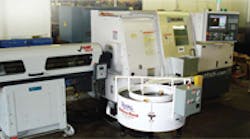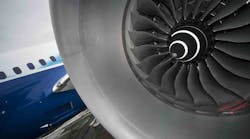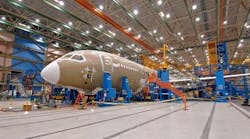Probably the simplest and most common automated machining system is the combination of a barfeeder, turning machine and some sort of part-catching receptacle – usually a bucket, basket or box.
The problem is, however, that finished parts can be damaged when machines spit them into these types of receptacles. Shops then are forced to station an operator at the machine to make sure this doesn’t happen, defeating the purpose of automation, which is to provide unmanned lights-out operation.
Frentzel Products Inc., which services the marine, oil and gas, sail boat, gas station parts and filtration industries, was faced with this dilemma when running a job consisting of a family of six parts, all made of brass.
“We had been running the job, which consists of about 50,000 parts total, on a gantry-style machine, but had to produce parts in batches by running a first operation on all of them, then a second operation,” Tom Frentzel Jr., president of Frentzel Products, said.
“So we purchased an Okuma L370 MW turning machine that featured a subspindle and added an LNS America barfeeder to it, with the goal of getting completely finished parts off the machine and operating unattended.”
The new machine and its barfeeder successfully produced completely finished parts. The next challenge, according to Frentzel, was how to get the parts out of the machine without damaging them.
He considered a robot, but the cost was more than the shop was willing to invest, and it did not want to have to deal with the integration and programming of a robot. Then the shop found an extremely cost-effective plug-and-play turntable-style parts catcher built by Royal Products.
The system is called Rota-Rack, and it safely collects finished parts coming off bar-fed CNC lathes for highly profitable, unmanned production. In addition, the compact system allows shops to run second or third shifts with the same equipment and without having to add employees. Also, day-shift operators are freed up to handle other moreproductive tasks.
The Rota-Rack eliminates workpiece damage, along with scrap and rework costs. This is especially beneficial when running parts with delicate external features such as threads, edges and corners. Plus, the system keeps parts in sequential order for quality control tracking.
Each time the Rota-Rack collects a finished part, the system’s turntable indexes to the next position to ensure that the following part will not forcefully collide with any of the previously collected parts. A special “spiral” keeps parts in sequential order.
As finished parts exit the lathe, they drop onto the Rota-Rack’s conveyor that moves them onto the system’s turntable, which gently guides them toward the center via the spiral. The degree of turntable rotation is easily adjusted according to part length, and after hours of unmanned operation, shops manually remove parts from the center of the system.
All contact surfaces of the system and its conveyor are covered with a high-lubricity UHMW plastic material that minimizes friction and protects part surface finishes.
Thanks to the Rota-Rack, Frentzel Products now gets about 25 to 30 hours of unattended/lights out machining from its Okuma turning machine. The system runs on its own from 2 am to 6 am, Tuesday through Friday mornings. Then on Friday afternoon, the shop sets up the machine to work four to five hours —determined by the amount of parts that fit on the Rota-Rack before needing unloaded — and collects parts Saturday morning.
On Saturday, the shop again sets up the machine to run four to five hours at the end of the day, collects the parts on Sunday, and gets the machine running another four to five hours until parts are collected Monday morning. Operators are involved only with the production to add bar stock to the barfeeder and periodically remove finished parts from the Rota-Rack.
Frentzel Products also benefits from the Rota-Rack’s ability to keep finished parts in sequential order for inspection/quality control purposes.
“When we come in on mornings, we check the last part run. And once in a while, an insert break occurs in the machine overnight, so we have to determine exactly where in the part run it happened. Since parts are in order on the Rota-Rack, we can quickly and easily find the last good part prior to the break, pull out the bad ones and fix them,” Frentzel said.
Setup and operation of the Rota- Rack is simple. Shops such as Frentzel Products enter the part cycle time and degree of turntable rotation via a simple PLC. The system does not have to be hooked up to the intended lathe’s CNC. A counter also can be set to shut the Rota-Rack down after a specified number of parts have been collected.
The Rota-Rack accommodates a variety of part lengths, diameters and shapes. As a general rule, the standard Rota-Rack works well for parts ranging in size from 0.250 in. in diameter by 1-in. long to those measuring 3 in. in diameter and 10-in. long. A slight spiral modification is required to handle longer parts.






